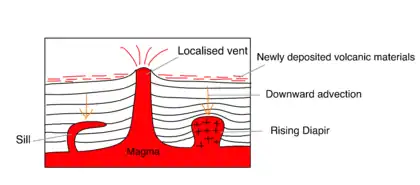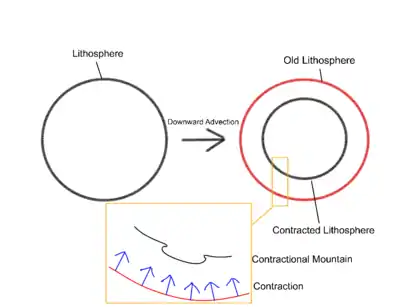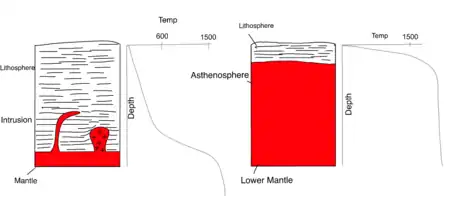Heat-pipe tectonics
Heat-pipe tectonics is a cooling mode of terrestrial planets and moons in which the main heat transport mechanism in the planet is volcanism through the outer hard shell, also called the lithosphere.[1][2] Heat-pipe tectonics initiates when volcanism becomes the dominant surface heat transfer process.[1] Melted rocks and other more volatile planetary materials are transferred from the mantle to surface via localised vents.[1] Melts cool down and solidify forming layers of cool volcanic materials.[1] Newly erupted materials deposit on top of and bury older layers.[1] The accumulation of volcanic layers on the shell and the corresponding evacuation of materials at depth cause the downward transfer of superficial materials such that the shell materials continuously descend toward the planet's interior.[1]
Heat-pipe tectonics was first introduced based on the observations on Io, one of the moons of Jupiter.[1][2] Io is a rocky body that is internally extremely hot; its heat is produced by tidal flexing associated with its eccentric orbit.[2][3][4][5] It releases internal heat via frequent and extensive volcanic eruptions that transfer melts to the surface.[2][6][7] Its crust is a single thick, dense and cold outer shell made up of layers of volcanic materials, whose rigidity and strength supports the weight of high mountains.[3][2][8]
Observations suggest that similar processes occurred in the early history of other terrestrial planets in the Solar System, i.e. Venus, the Moon, Mars, Mercury and Earth, indicating they may preserve fossil heat-pipe evidence.[9] Every terrestrial body in our Solar System might have had heat-pipe tectonics at some point; heat-pipe tectonics may thus be a universal early cooling mode of terrestrial bodies.[9]
Theory



In heat-pipe tectonics, volcanism is the major heat transport mechanism in which melts of rock are transferred to the surface by localised vents.[1][3][9] Advection, referring to the transfer of mass and heat, occurs when a moving fluid carries substances or heat to or away from a source and through a surrounding solid along channels.[10] Melts are produced when mantle rocks bear temperatures between 1100 and 2400 °C at corresponding depths (pressure varies the melting temperature) with the presence of water.[11][12] When melts reach surface via vertical vents, they cool down and solidify forming mafic or ultramafic rocks which are rich in iron and magnesium.[1][9] A thicker lithosphere is formed when volcanic materials accumulate on the Earth’s surface via repetitive volcanic eruptions.[1][9] The new materials at the top, with the corresponding void created in the planet interior, lead to the sinking of superficial deposits.[1][9]
This vertical advection of volcanic materials causes compression of the lithosphere, because interior spherical shells of planets are progressively becoming smaller at increasing depths.[1][9] The surface cools down and a cold, dense and strong lithosphere is developed.[1][9] The thick lithosphere supports the mountains that result from the contraction of volcanic layers.[1][9]
Cooling heat-pipe planets could enter the next stage of cooling history, either lid tectonics or plate tectonics, immediately from the heat-pipe stage after prolonged cooling.[1][13]
Inspiration from Io
Io, a moon of Jupiter, is a small terrestrial planet, its radius is 1821.6±0.5 km, with a size similar to the Moon's.[14] Yet, Io produces a much higher heat flow, 60~160 terawatts (TW), which is 40 times larger than that on Earth.[3][2][15][16] Radioactive decay cannot generate this large amount of heat. Radioactive decay supplies heating on other terrestrial planets.[3][2] Instead, tidal-generated heat is a better hypothesis as Io is under great tidal influence imposed by Jupiter and other large moons of Jupiter, similar to the Earth and the Moon.[3]
The first observation supporting this was the active volcanism found on Io. There are over 100 calderas with abundant and widely spread radiating lava flows.[2][6][7] And the composition of the lava is interpreted to be mainly sulfur and silicates from the high eruption temperature of at least 1200 K.[3]
In addition to extensive volcanism, mountain ranges are the second observation on Io's surface. Io has 100~150 mountains with mean height of 6 km and a maximum height of 17 km.[3][2] Mountains found have no tectonic evidence of their origin. Neither are there volcanoes in the mountainous areas.[3][2]
A hypothesis of the development of thick lithosphere is built on these observations.[2][7] The old theory suggested any terrestrial planets have a thin lithosphere. However, a thin 5-km-thick lithosphere cannot withstand the large stress of 6 kbar exerted by a 10 km×10 km mountain.[2][8] To compare, the maximum stress that the lithosphere of the Earth can withstand is 2 kbar.[2] Thus, Io requires a thicker lithosphere to bear the overwhelming stresses imposed by globally distributed mountains.[2]
Heat-pipe tectonics was then introduced to explain the situation on Io. The theory explains the globally distributed volcanic materials on the surface; the development of thick lithosphere; and the formation of contractional mountains.[3][2]
Fossil heat-pipes in other terrestrial planets in the Solar System
Research in 2017 suggested that all terrestrial planets may possibly undergo volcanism to cool down in their early development when they were much hotter inside than at present.[1][9][13] In the Solar System, Mars, the Moon, Mercury, Venus and Earth show evidence of past heat pipe tectonics, while not undergoing it at present.[9]
| Evidence | Explanation | |
| Mercury | - Lobate scarps record limited lithospheric contraction.[9][17][18]
- Large scale volcanism dominated the heat transfer mechanism until 4 billion years ago, smoothing out the surface.[9] - No volcano can be found, but evidence of volcanism covers an extensive area.[9] - Lava spilling out through the vent can flow easily over a large area, matching the mafic composition.[9][19][20] |
- Little earlier structure and shape of the planet can be preserved under continuous volcanic resurfacing.[9]
- Structures and special landscapes can only be preserved after heat-pipe tectonics terminates. This explains the limited contraction.[9] - Mafic volcanic materials and its formation match with the hypothesis of heat-pipe tectonics.[9] |
| Moon | - The shape of the Moon is not a perfect circle, but a slightly flattened circle.[9] | - The changes in shape must be recorded and preserved, but only in a strong and thick lithosphere. Heat-pipe tectonics develops a strong and thick lithosphere quickly so that the shape could be preserved.[9] |
| Mars | - The Martian dichotomy: great topographical contrast between the depression in the Martian northern hemisphere and the elevated southern hemisphere.[9]
- Wide isotopic range of neodymium (Nd), i.e. four times of that on Earth.[9][21] |
- Heat-pipe tectonics produces a thick and strong lithosphere which could preserve the older shape and topographies.[9]
- The first shell on Mars is formed by an immediate accumulation of the incompatible elements, such as neodymium.[9][21] |
| Venus | - Structures in Ovda Regio, a high plain, show vertical advection of superficial materials.[9][22] | - Downward advection of surficial materials and the formation of the thick lithosphere in the high plain match with the heat-pipe tectonics.[9] |
Heat-pipe Earth
A hypothesis has been introduced to the early Earth that the Earth followed heat-pipe tectonics theory and cooled down through volcanism.[1] From 4.5 billion years ago, the earth started cooling until 3.2 billion years ago when plate tectonics started.[1][23] The age of plate tectonics initiation is verified by several pieces of evidence such as Wilson Cycle.[1][23]
Existing theories and constraints
Two major existing theories explain early Earth tectonics, namely proto-plate tectonics and vertical tectonics.[1][24]
| Previous Theories | Motion | Example[1][24][25] |
| Proto-plate tectonics | Horizontal | - Compressional
- Extensional |
| Vertical Tectonics | Vertical | - Sub/intra-lithospheric inverse-drip shaped intrusion |
New observations in Barberton, South Africa and Pilbara, Australia show no evidence of periods of non-diapiric deformation that lasted more than 300 million years.[1] Applying the existing theories to explain the deformation, upward inverse-drip shaped intrusion of melts is the solution.[1][26][27] In this case, horizontal motions must be involved.[1] Yet, no proof of horizontal motion could be found.[1] Based on this, some researchers applied heat-pipe tectonics to the early Earth.
Heat-pipe evidence
| Place | Observations | Heat-pipe Hypothesis |
| Barberton and Pilbara | - Thick sequenced volcanic materials (rich in iron and magnesium), i.e. 12-km thick, in Pilbara.[1][27][28][29]
- Upward inverse-drip shaped intrusion metamorphose the volcanic layers into TTG (Tonalite - trondhjemite - granodiorite).[1] - Dome-shaped structures resulted from the intrusion.[1] - No deformational structure found until 3.2 billion years ago.[1] - Tectonism-induced structure found right after 3.2 billion years ago: |
- Constant volcanic eruption through localised vents creates thick lithosphere (rich in iron and magnesium). [1]
- No tectonism until 3.2 billion years ago.[1] - Intrusions occur at the base of the lithosphere.[1] |
| Itsaq | - Most rocks older than 3.2 billion years ago are gneiss (4.03 billion years ago).[1][31][32]
- Some deformations were found earlier than 3.2 billion years.[1] |
- Planets cool down over time in heat-pipe tectonics.[1]
- Subduction could explain the deformation, as planets should cool down after subduction. But the process is slow and progressive, which takes a long period to cool down after subduction events.[1][33] - Yet, no tectonic evidence can prove the occurrence of subduction.[1] - Long-existing reverse faults with overlapping pattern (Duplex) is a better explanation. It does not involve any subduction and thus no cooling after any processes.[1] - A sharp decline in heat-pipe tectonics after 3.2 billion years ago.[1] |
Beyond heat-pipe tectonics
As time goes by, terrestrial planets cool down as internal heat production reduces and the surface temperature becomes lower.[1][13] On top of that, the major heat transfer process is changing towards conduction.[1][13] Thus, an abrupt transition from heat-pipe tectonics to either plate tectonics or stagnant lid tectonics occurs when conduction heat is larger than the internal heat production.[1][13][34]
Stagnant lid refers to the relatively stable and immobile strong cold lithosphere with little horizontal movements, while plate tectonics, refers to the mobile lithosphere with many horizontal movements.[9]
In the plate tectonic stage, the plate starts breaking up when convective stresses driven by the mantle overcome lithospheric strength.[13] As volcanism is no longer the dominant heat transfer method, much less volcanic material would be deposited globally.[13] A thinner lithosphere is then developed with increasing lithospheric temperature gradient, i.e. 1500 degree Celsius at 100-km depth).[35]
References
- Moore, William B.; Webb, A. Alexander G. (2013). "Heat-pipe Earth". Nature. 501 (7468): 501–505. Bibcode:2013Natur.501..501M. doi:10.1038/nature12473. ISSN 0028-0836. PMID 24067709. S2CID 4391599.
- O'Reilly, Thomas C.; Davies, Geoffrey F. (1981). "Magma transport of heat on Io: A mechanism allowing a thick lithosphere". Geophysical Research Letters. 8 (4): 313–316. Bibcode:1981GeoRL...8..313O. doi:10.1029/gl008i004p00313. ISSN 0094-8276.
- Breuer, D.; Moore, W.B. (2007), "Dynamics and Thermal History of the Terrestrial Planets, the Moon, and Io", Treatise on Geophysics, Elsevier, pp. 299–348, doi:10.1016/b978-044452748-6.00161-9, ISBN 9780444527486
- Tackley, P (2001). "Three-Dimensional Simulations of Mantle Convection in Io". Icarus. 149 (1): 79–93. Bibcode:2001Icar..149...79T. doi:10.1006/icar.2000.6536. ISSN 0019-1035. S2CID 15288576.
- PEALE, S. J.; CASSEN, P.; REYNOLDS, R. T. (1979-03-02). "Melting of Io by Tidal Dissipation". Science. 203 (4383): 892–894. Bibcode:1979Sci...203..892P. doi:10.1126/science.203.4383.892. ISSN 0036-8075. PMID 17771724. S2CID 21271617.
- SMITH, B. A.; SODERBLOM, L. A.; JOHNSON, T. V.; INGERSOLL, A. P.; COLLINS, S. A.; SHOEMAKER, E. M.; HUNT, G. E.; MASURSKY, H.; CARR, M. H.; DAVIES, M. E.; COOK, A. F. (1979-06-01). "The Jupiter System Through the Eyes of Voyager 1". Science. 204 (4396): 951–972. Bibcode:1979Sci...204..951S. doi:10.1126/science.204.4396.951. ISSN 0036-8075. PMID 17800430. S2CID 33147728.
- Carr, M. H.; Masursky, H.; Strom, R. G.; Terrile, R. J. (1979). "Volcanic features of Io". Nature. 280 (5725): 729–733. Bibcode:1979Natur.280..729C. doi:10.1038/280729a0. ISSN 0028-0836.
- McNutt, Marcia (1980-11-10). "Implications of regional gravity for state of stress in the Earth's crust and upper mantle". Journal of Geophysical Research: Solid Earth. 85 (B11): 6377–6396. Bibcode:1980JGR....85.6377M. doi:10.1029/jb085ib11p06377. ISSN 0148-0227.
- Moore, William B.; Simon, Justin I.; Webb, A. Alexander G. (2017). "Heat-pipe planets". Earth and Planetary Science Letters. 474: 13–19. Bibcode:2017E&PSL.474...13M. doi:10.1016/j.epsl.2017.06.015. ISSN 0012-821X.
- Zhao, Chongbin; Hobbs, Bruce E.; Ord, Alison (2008), "Introduction", Convective and Advective Heat Transfer in Geological Systems, Springer Berlin Heidelberg, pp. 1–5, doi:10.1007/978-3-540-79511-7_1, ISBN 9783540795100
- Takahashi, Eiichi (1986). "Melting of a dry peridotite KLB-1 up to 14 GPa: Implications on the Origin of peridotitic upper mantle". Journal of Geophysical Research. 91 (B9): 9367–9382. Bibcode:1986JGR....91.9367T. doi:10.1029/jb091ib09p09367. ISSN 0148-0227.
- BOWEN, NORMAN L. (1947). "MAGMAS". Geological Society of America Bulletin. 58 (4): 263. doi:10.1130/0016-7606(1947)58[263:m]2.0.co;2. ISSN 0016-7606.
- Kankanamge, Duminda G. J.; Moore, William B. (2016-04-14). "Heat transport in the Hadean mantle: From heat pipes to plates". Geophysical Research Letters. 43 (7): 3208–3214. Bibcode:2016GeoRL..43.3208K. doi:10.1002/2015gl067411. ISSN 0094-8276.
- "Planetary Satellite Physical Parameters". ssd.jpl.nasa.gov. Retrieved 2019-11-11.
- Veeder, Glenn J.; Davies, Ashley Gerard; Matson, Dennis L.; Johnson, Torrence V.; Williams, David A.; Radebaugh, Jani (2012). "Io: Volcanic thermal sources and global heat flow". Icarus. 219 (2): 701–722. Bibcode:2012Icar..219..701V. doi:10.1016/j.icarus.2012.04.004. ISSN 0019-1035.
- Davies, J. H.; Davies, D. R. (2010-02-22). "Earth's surface heat flux". Solid Earth. 1 (1): 5–24. doi:10.5194/se-1-5-2010. ISSN 1869-9529.
- Watters, Thomas R.; Solomon, Sean C.; Robinson, Mark S.; Head, James W.; André, Sarah L.; Hauck, Steven A.; Murchie, Scott L. (2009). "The tectonics of Mercury: The view after MESSENGER's first flyby". Earth and Planetary Science Letters. 285 (3–4): 283–296. Bibcode:2009E&PSL.285..283W. doi:10.1016/j.epsl.2009.01.025. ISSN 0012-821X.
- Di Achille, G.; Popa, C.; Massironi, M.; Mazzotta Epifani, E.; Zusi, M.; Cremonese, G.; Palumbo, P. (2012). "Mercury's radius change estimates revisited using MESSENGER data". Icarus. 221 (1): 456–460. Bibcode:2012Icar..221..456D. doi:10.1016/j.icarus.2012.07.005. ISSN 0019-1035.
- Wigginton, N. S. (2011-06-30). "Iron et Al". Science. 333 (6038): 15. Bibcode:2011Sci...333...15W. doi:10.1126/science.333.6038.15-c. ISSN 0036-8075.
- Wang, Shifeng; Murphy, Michael A.; Phillips, Richard J.; Wang, Chao (2013). "Reply to comment on "Displacement along the Karakoram fault, NW Himalaya, estimated from LA-ICPMS U–Pb dating of offset geologic markers" published by Leloup et al. in EPSL, 2013". Earth and Planetary Science Letters. 363: 246–248. Bibcode:2013E&PSL.363..246W. doi:10.1016/j.epsl.2012.11.052. ISSN 0012-821X.
- Humayun, M.; Nemchin, A.; Zanda, B.; Hewins, R. H.; Grange, M.; Kennedy, A.; Lorand, J.-P.; Göpel, C.; Fieni, C.; Pont, S.; Deldicque, D. (2013). "Origin and age of the earliest Martian crust from meteorite NWA 7533". Nature. 503 (7477): 513–516. Bibcode:2013Natur.503..513H. doi:10.1038/nature12764. ISSN 0028-0836. PMID 24256724. S2CID 205236433.
- Turcotte, D. L. (1989-03-10). "A heat pipe mechanism for volcanism and tectonics on Venus". Journal of Geophysical Research: Solid Earth. 94 (B3): 2779–2785. Bibcode:1989JGR....94.2779T. doi:10.1029/jb094ib03p02779. hdl:2060/19890009853. ISSN 0148-0227. S2CID 129112462.
- Pease, Victoria; Percival, John; Smithies, Hugh; Stevens, Gary; Van Kranendonk, Martin (2008), "When did plate tectonics begin? Evidence from the orogenic record", Special Paper 440: When Did Plate Tectonics Begin on Planet Earth?, Geological Society of America, pp. 199–228, doi:10.1130/2008.2440(10), ISBN 9780813724409
- Stern, Robert J. (2008), "Modern-style plate tectonics began in Neoproterozoic time: An alternative interpretation of Earth's tectonic history", Special Paper 440: When Did Plate Tectonics Begin on Planet Earth?, vol. 440, Geological Society of America, pp. 265–280, doi:10.1130/2008.2440(13), ISBN 9780813724409
- Harrison, T. Mark (2009). "The Hadean Crust: Evidence from >4 Ga Zircons". Annual Review of Earth and Planetary Sciences. 37 (1): 479–505. Bibcode:2009AREPS..37..479H. doi:10.1146/annurev.earth.031208.100151. ISSN 0084-6597. S2CID 32636449.
- Van Kranendonk, Martin J. (2011). "Cool greenstone drips and the role of partial convective overturn in Barberton greenstone belt evolution". Journal of African Earth Sciences. 60 (5): 346–352. Bibcode:2011JAfES..60..346V. doi:10.1016/j.jafrearsci.2011.03.012. ISSN 1464-343X.
- Smithies, Robert H.; Champion, David C.; Van Kranendonk, Martin J. (2019), "The Oldest Well-Preserved Felsic Volcanic Rocks on Earth", Earth's Oldest Rocks, Elsevier, pp. 463–486, doi:10.1016/b978-0-444-63901-1.00020-4, ISBN 9780444639011
- Stiegler, M. T.; Lowe, D. R.; Byerly, G. R. (2011-01-21). "Fragmentation and dispersal of komatiitic pyroclasts in the 3.5-3.2 Ga Onverwacht Group, Barberton greenstone belt, South Africa". Geological Society of America Bulletin. 123 (5–6): 1112–1126. Bibcode:2011GSAB..123.1112S. doi:10.1130/b30191.1. ISSN 0016-7606.
- Eriksson, P.G.; Altermann, W.; Nelson, D.R.; Mueller, W.U.; Catuneanu, O. (2004), "The Early Earth", The Precambrian Earth - Tempos and Events, Elsevier, pp. 1–63, doi:10.1016/s0166-2635(04)80003-3, ISBN 9780444515063
- Pease, Victoria; Percival, John; Smithies, Hugh; Stevens, Gary; Van Kranendonk, Martin (2008), "When did plate tectonics begin? Evidence from the orogenic record", Special Paper 440: When Did Plate Tectonics Begin on Planet Earth?, Geological Society of America, pp. 199–228, doi:10.1130/2008.2440(10), ISBN 9780813724409
- Bowring, Samuel A.; Williams, Ian S. (1999-01-21). "Priscoan (4.00-4.03 Ga) orthogneisses from northwestern Canada". Contributions to Mineralogy and Petrology. 134 (1): 3–16. Bibcode:1999CoMP..134....3B. doi:10.1007/s004100050465. ISSN 0010-7999. S2CID 128376754.
- Friend, Clark R. L.; Nutman, Allen P. (2005). "Complex 3670–3500 Ma Orogenic Episodes Superimposed on Juvenile Crust Accreted between 3850 and 3690 Ma, Itsaq Gneiss Complex, Southern West Greenland". The Journal of Geology. 113 (4): 375–397. Bibcode:2005JG....113..375F. doi:10.1086/430239. ISSN 0022-1376. S2CID 128974976.
- Nutman, A. P.; Friend, C. R. L. (2007-11-02). "Comment on "A Vestige of Earth's Oldest Ophiolite"". Science. 318 (5851): 746c. Bibcode:2007Sci...318..746N. doi:10.1126/science.1144148. ISSN 0036-8075. PMID 17975049.
- Fowler, A. C. (1985). "Fast Thermoviscous Convection". Studies in Applied Mathematics. 72 (3): 189–219. doi:10.1002/sapm1985723189. ISSN 0022-2526.
- Arevalo, Ricardo; McDonough, William F.; Luong, Mario (2009). "The K/U ratio of the silicate Earth: Insights into mantle composition, structure and thermal evolution". Earth and Planetary Science Letters. 278 (3–4): 361–369. Bibcode:2009E&PSL.278..361A. doi:10.1016/j.epsl.2008.12.023. ISSN 0012-821X.